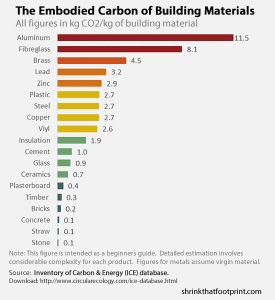Embodied Energy of Materials - 76
If we are careful in our choice of materials and processes we can minimise the ecological impact during a buildings construction and in its long term use.
Energy is consumed to extract or harvest the raw materials that are used in construction products. More energy is used to transport these raw materials to the factories, where even more energy is used to transform the raw materials into finished construction products. All the energy consumed at each step along the way can be thought of as being 'trapped' or embodied in the final product. All the energy used up to the point where the construction material is ready to be shipped to the consumer is included. The term used to describe this is 'cradle to gate' - meaning from the source of the raw material (e.g. forest) to the factory gate.
Embodied energy is one of the key factors used to assess the sustainability of a construction material or product. Sustainable materials and products have low levels of embodied energy. A material that is locally sourced and is relatively un-processed will have a low level of embodied energy. Materials that have high levels of embodied energy are generally not sustainable and should be avoided where possible.
While it is often true that the embodied energy of a material may be insignificant, compared to the energy-saving potential a material offers over the lifetime of a building, we should always aim to find and use materials which deliver on all aspects of environmental sustainability.
Selecting materials for all the elements of a building is a complex and difficult task that requires careful consideration.
Key Principles in assessing embodied energy of materials
The energy consumed in producing, transporting, installing, maintaining and disposing of construction materials and products represents between 10% and 25% of the total lifetime energy consumption of a typical building. However, for low-energy buildings this figure can be as high as 50%. This is a really important point because it means that the impact of building materials is becoming much more important as more energy-efficient buildings are being designed and built.
This idea is also very important for building design because it means that a balance has to be struck between the contribution a material makes to the energy efficiency of a building and the energy cost of producing that material. This is particularly relevant for insulation products. There comes a point at which it no longer makes sense to increase the thickness of insulation in a building because the energy saving achieved during the lifetime of the building or product is outweighed by the energy consumed to produce that insulation product.
Every company that sells construction materials and products is aware of the importance of making their products appear as 'green' as possible and most companies promote their system or product as being 'greener' or more sustainable than those of their competitors.
To help us draw a clear distinction between natural and processed building materials, it is useful to pigeonhole materials into five main groupings:
Short term renewable origin (timber, wool, straw etc)
Extracted or mined (earth, sand and gravel)
Extracted and further processed (lime, cement, plaster, slate, stone, brick)
Extracted and highly processed (steel, glass and plastics)
Recycled or reclaimed (reused timber, brick, aggregate, steel, glass, insulation).
Key Principles for selecting sustainable construction materials
Embodied Carbon
They are designed for low energy use - they minimise the energy required to 'run' the building.
They minimise the use of new resources - they are made using recovered, reused and recycled materials.
They use whole unprocessed materials - materials like solid timber (in the round), natural stone, earth, clay and products that use natural fibres
They have a low embodied energy - the energy used during the extraction/harvesting, manufacture and transport of a construction material
They can be reused - for example, using lime-based mortar instead of cement-based mortar allows bricks to be reused because a lime mortar is softer than the brick and can be cleaned off without damaging the brick
They contribute to a healthy indoor environment - for example, natural paints that do not emit volatile organic compounds (VOCs) and natural fibre (e.g. wool) carpets.
Key principles for selecting low embodied energy materials
No product or material will be perfect in every respect. As an architect, we have to consider a wide range of information and possibilities and then try to select the best solution.
Source heavyweight materials locally: heavy materials like stone, aggregates and bricks should be purchased from local quarries and manufacturers because of the high amount of fuel required to transport heavy materials.
Source lightweight materials globally: the proportion of embodied energy that is linked to transport is much smaller for lightweight materials (e.g. aluminium or PVC), especially when compared to the energy used in their manufacture. Many lightweight construction materials compensate for the embodied energy gained during manufacture by saving energy in the building once installed. For example, the aluminium foil used in insulation products saves lots of energy by reducing heat loss.
Source materials with a high potential for reuse and recycling: the embodied energy that remains 'trapped' in materials at the end of a building's life should not be wasted by sending the materials to landfill.
Life cycle assessment (LCA) is a tool used to calculate the environmental impact of a material or product. LCA takes into account all associated inputs and emissions, including:
Energy consumption
Greenhouse gas emissions
Resource consumption (e.g. water)
Waste
Pollution (air, water, land).
Both embodied energy and LCA need to be carefully considered when specifying materials and products for a project as they can have a major effect on the overall sustainability of a scheme.
Hickey, T. (2014) 'Designing sustainable homes’, Construction Technology, pp. 102-106 Chapter 10
The Green Building Bible Vol.1, pp. 195-198, Materials and Methods, Chapter 4


